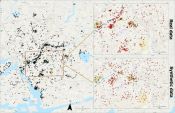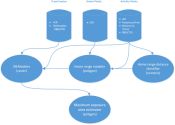Open access tools and data
Hupmobile’s Participatory Tools

When developing sustainable mobility solutions and supporting sustainable urban lifestyles, it is essential to truly understand the perspectives of various kinds of urban dwellers. There is also an obvious need to integrate the perspectives of people to planning solutions to promote sustainable mobility patterns and to develop more influential participation. New, digital methods help to achieve these objectives and therefore we are currently working in Hupmobile project to create a toolbox of methods for public participation that combines the benefits that digital and traditional methods can provide.
Synthetic PPGIS data generation

PPGIS is widely used in urban and environmental research. Collection of this data for purely methodological purposes may be costly and unnecessary. Therefore, we developed a context-aware method that can learn from previously collected PPGIS data and create a realistic dataset that can be used for methodological development purposes. The synthetic data can be generated for any desired geographical extent in both 2D and 3D, i.e. with Z coordinates. The latter is particularly important as 3D PPGIS is an emerging frontier and limited infrastructures currently exist for collection of such data. Hence, while the relevant technology is developing, spatial analytical developments can also advance using such synthetic data. This method:
- Learns from existing 2D and 3D PPGIS data in relation to the geographical context.
- Creates a realistic and context-aware simulated PPGIS point dataset.
Everyday urban environment (urbArki-2009)

The softGIS team led by professor Marketta Kyttä at Aalto University is determined to publish their datasets online for further use for research, pratcice related, and educational purposes. All datasets will be anonymized using the team’s own novel anonymization algorithms to protect sensitive data and comply with GDPR, while maintaining the overal data quality (learn more). The team’s plan is to publish PPGIS data from past and future projects on a rolling basis to their dedicated community of Zenodo.
This dataset is collected as part of the Urban Everyday (Urbaani Arki, 2009) project and includes the following information: Home locations, everyday errand points, suggestion points, and appeal points.
ActiveAge data (AAGE-2015)

The softGIS team led by professor Marketta Kyttä at Aalto University is determined to publish their datasets online for further use for research, pratcice related, and educational purposes. All datasets will be anonymized using the team’s own novel anonymization algorithms to protect sensitive data and comply with GDPR, while maintaining the overal data quality (learn more). The team’s plan is to publish PPGIS data from past and future projects on a rolling basis to their dedicated community of Zenodo.
This dataset is collected as part of the ActiveAge project (2015) and includes the following information: Home locations, everyday errand points, and happy places.
Urban Happiness (urbOnni-2009)

The softGIS team led by professor Marketta Kyttä at Aalto University is determined to publish their datasets online for further use for research, pratcice related, and educational purposes. All datasets will be anonymized using the team’s own novel anonymization algorithms to protect sensitive data and comply with GDPR, while maintaining the overal data quality (learn more). The team’s plan is to publish PPGIS data from past and future projects on a rolling basis to their dedicated community of Zenodo.
This dataset is collected as part of the Urban Happiness project (2009) and includes the following information: Home locations, everyday errand points, Helsinki experience points, and Espoo experience points.
Data: PPGIS survey collected across 13 study sites in ten European countries in 2015-16
This data set includes responses to a PPGIS survey collected across 13 study sites in ten European countries in 2015-16. Metadata and download link: urn.fi/urn:nbn:fi:att:2fc777d5-e7f0-4efd-9560-5bfd292fed73
Data relates to publications:
Plieninger, T., Torralba, M., Hartel, T. & Fagerholm, N. (2019). Perceived ecosystem services synergies, trade-offs, and bundles in European high nature value farming landscapes. Landscape Ecology 34 (7), 1565-1581. doi.org/10.1007/s10980-019-00775-1
Fagerholm, N., Torralba, M., Moreno, G., Girardello, M., Herzog, F., Aviron, S., Burgess. P., Crous, J., Ferreiro-Domínguez, N., Graves, A., Hartel, T., Măcicăsan, V., Kay, S., Pantera, A., Varga, A. & Plieninger, T. (2019). Cross-site analysis of perceived ecosystem service benefits in multifunctional landscapes. Global Environmental Change 56, 134-147. doi.org/10.1016/j.gloenvcha.2019.04.002
Fagerholm, N., Martín‐López, B., Torralba, M., Oteros‐Rozas, E., Lechner, A.M., Bieling, C., Stahl Olafsson, A., Albert, C., Raymond, C.M., Garcia‐Martin, M., Gulsrud, N., & Plieninger, T. (2020). Perceived contributions of multifunctional landscapes to human well‐being: Evidence from 13 European sites. People and Nature, 2, 217-234. doi.org/10.1002/pan3.10067
IASM: Individualized activity space modeler

Researchers from various disciplines have long been interested in analyzing and describing human mobility patterns. Activity space (AS), defined as an area encapsulating daily human mobility and activities, has been at the center of this interest. However, given the applied nature of research in this field and the complexity that advanced geographical modeling can pose to its users, the proposed models remain simplistic and inaccurate in many cases. Individualized Activity Space Modeler (IASM) is a geographic information system (GIS) toolbox, written in Python programming language using ESRI’s Arcpy module, comprising four tools aiming to facilitate the use of advanced activity space models in empirical research. IASM provides individual-based and context-sensitive tools to estimate home range distances, delineate activity spaces, and model place exposures using individualized geographical data. In this paper, we describe the design and functionality of IASM, and provide an example of how it performs on a spatial dataset collected through an online map-based survey.